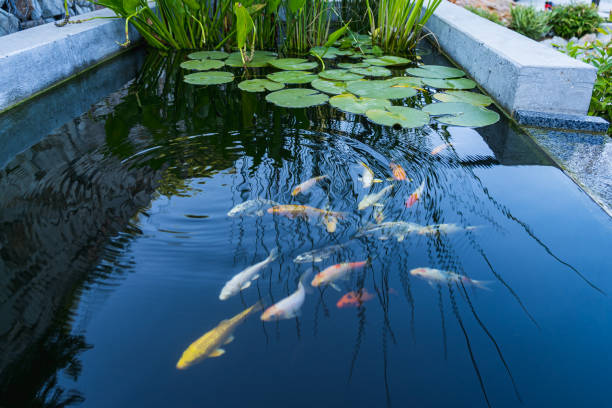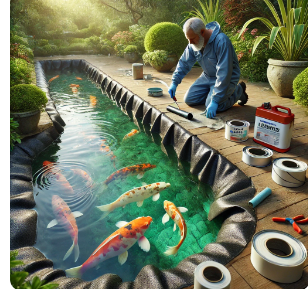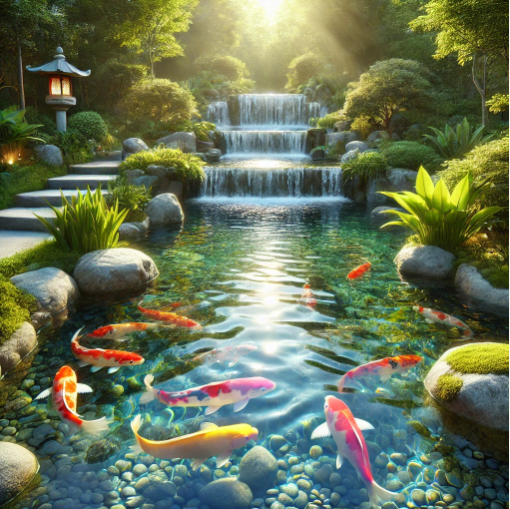Building a koi pond is not just about aesthetics—it’s about creating a healthy, spacious environment where koi can thrive. A well-sized pond ensures better water quality, healthy fish growth, and easier maintenance.
So, how big should a koi pond be? Let’s break it down by size, depth, fish capacity, and essential factors to consider.
1. What Is the Ideal Size for a Koi Pond?
The size of a koi pond depends on how many fish you plan to keep and how large you want them to grow.
✔ Minimum pond size for koi: 1,000 gallons
✔ Ideal pond size for jumbo koi: 5,000+ gallons
Here’s a general guideline based on the number of koi fish:
| Number of Koi | Recommended Pond Size | Ideal Depth |
| 1-2 koi | 1,000 gallons | 3 feet |
| 3-5 koi | 2,000 gallons | 4 feet |
| 6-10 koi | 3,000-5,000 gallons | 5+ feet |
| 10+ koi | 6,000+ gallons | 6+ feet |
📌 Fact: Koi can grow over 3 feet long, so they need plenty of swimming space.
2. How Deep Should a Koi Pond Be?
Depth is just as important as surface area when designing a koi pond.
✔ Minimum depth for koi ponds: 3 feet
✔ Ideal depth for large koi: 4-6 feet
Why Does Pond Depth Matter?
- Prevents predators – Shallow ponds make koi easy targets for herons, raccoons, and cats.
- Regulates water temperature – Deeper ponds stay cooler in summer and warmer in winter.
- Encourages koi growth – More depth allows koi to swim freely and develop properly.
- Reduces algae issues – Shallow ponds heat up faster, causing algae blooms.
📌 Tip: If you live in cold regions, build a deeper pond (4-6 feet) to prevent freezing in winter.
3. How Many Koi Can a Pond Hold?
Overcrowding a koi pond leads to poor water quality, stunted growth, and stress-related diseases.
✔ General rule: 1 koi per 250 gallons for small koi, or 1 koi per 500 gallons for large koi.
Example Calculations
- A 1,000-gallon pond can hold 4 small koi or 2 large koi.
- A 3,000-gallon pond can hold 12 small koi or 6 large koi.
- A 5,000-gallon pond can hold 20 small koi or 10 large koi.
📌 Tip: If you want koi to grow to their full potential, avoid overstocking your pond.
4. Factors to Consider When Sizing a Koi Pond
1. Space Availability
- Choose a location with enough room for future expansion.
- Avoid placing ponds too close to trees (to reduce falling leaves).
2. Filtration & Oxygenation
- Larger ponds require stronger filtration systems to maintain clean water.
- Aerators, waterfalls, or fountains help increase oxygen levels.
3. Maintenance & Costs
- Bigger ponds require more upkeep but offer better water stability.
- Consider water changes, filter cleaning, and electricity costs.
📌 Tip: A bigger pond is easier to maintain than a small one, as it balances water conditions better.
5. What If You Have a Small Backyard?
If you have limited space, you can still enjoy keeping koi with a compact pond setup.
✔ Minimum pond size: 500 gallons
✔ Best depth: 3 feet minimum
✔ Recommended koi count: 1-3 koi max
You can also consider:
- Raised koi ponds (easier to maintain)
- Stock tank koi ponds (low-maintenance alternative)
- Indoor koi tanks (for small koi)
📌 Tip: If you start with a small pond, ensure it’s deep enough and well-filtered for koi health.
6. Final Thoughts: What’s the Best Koi Pond Size?
✔ The minimum size for a koi pond should be 1,000 gallons and 3 feet deep.
✔ Larger ponds (3,000-5,000+ gallons) allow koi to grow bigger and live longer.
✔ Depth is key—aim for 4-6 feet for better temperature control and predator protection.
✔ Avoid overcrowding—1 koi per 250-500 gallons is ideal.
If you want healthy, thriving koi, focus on ample space, proper depth, and strong filtration. A well-planned pond will keep your koi happy for decades! 🐟💦




